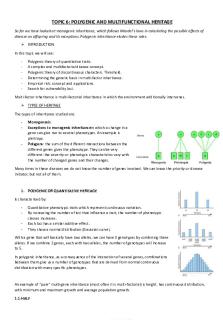Momentsof Inertia - Lecture notes 6 PDF

| Title | Momentsof Inertia - Lecture notes 6 |
|---|---|
| Author | QUANG NGUYEN |
| Course | Physics Ii |
| Institution | Michigan State University |
| Pages | 3 |
| File Size | 101.4 KB |
| File Type | |
| Total Downloads | 94 |
| Total Views | 146 |
Summary
Moments of Inertia...
Description
Moments of Inertia for Ring, Disc and Sphere
Ring of mass M and radius R All mass is distance R away from the center. Axis of rotation passes through the center perpendicularly to the disc: ∫
∫
∫
Disc (thin) of mass M and radius R Disc can be thought of as a collection of rings with radii going from 0 to R. Then to get the moment inertia of the disc, we sum up (integrate over) the moments of inertia of all the rings: ∫ .
For a disc, mass is distributed over its surface; so, the mass density is Mass/Surface Area, which gives: . Infinitesimal surface area of the disc is , which is circumference of a ring multiplied by its thickness , so that
∫
∫
∫
. Therefore:
∫
Solid cylinder of mass M, radius R and length L Solid cylinder can be thought of as a collection of discs of specific thickness with radii going from 0 to R, stacked along the z-axis. Then to get the moment inertia of the cylinder, we sum up (integrate over) the moments of inertia of all the discs: ∫ .
For a cylinder of finite thickness, mass is distributed inside its volume; so, the mass density is Mass/Volume. Since these discs comprise the cylinder Mass/Volume can be found as: (total mass of the cylinder divided by the total volume of the cylinder). Infinitesimal volume of the cylinder is , which is surface area of the disc multiplied by its thickness , so that . Therefore: ∫
∫
∫
∫
Solid Sphere of mass M and radius R Solid sphere can be thought of as a collection of discs of specific thickness with radii going from 0 to R, stacked along the z -axis. Then, to get the moment inertia of the sphere, we sum up (integrate over) the moments of inertia of all the discs: ∫ .
For a disc of finite thickness, mass is distributed inside its volume; so, the mass density is Mass/Volume. Since these discs comprise the solid sphere Mass/Volume can be found as: (total mass of the sphere divided by the total volume of the sphere). Infinitesimal volume of the disc is , which is surface area of the disc multiplied by its thickness , so that . Therefore: ∫
∫
∫
∫
Now, coordinates r and z are not unrelated; they relate as
∫
∫
,
, so that...
Similar Free PDFs

Lecture notes, lecture 6
- 3 Pages

Ch 6 - Lecture notes 6
- 3 Pages

Chapter 6 - Lecture notes 6
- 5 Pages

Module 6 - Lecture notes 6
- 2 Pages

Chapter 6 - Lecture notes 6
- 6 Pages

Chapter 6 - Lecture notes 6
- 9 Pages

Anth101 6 - Lecture notes 6
- 4 Pages

Chapitre 6 - Lecture notes 6
- 2 Pages

Lec 6 - Lecture notes 6
- 3 Pages

Ch 6 - Lecture notes 6
- 4 Pages

Chapter 6 - Lecture notes 6
- 11 Pages

Unit 6 - Lecture notes 6
- 7 Pages

Assignment 6 - Lecture notes 6
- 5 Pages
Popular Institutions
- Tinajero National High School - Annex
- Politeknik Caltex Riau
- Yokohama City University
- SGT University
- University of Al-Qadisiyah
- Divine Word College of Vigan
- Techniek College Rotterdam
- Universidade de Santiago
- Universiti Teknologi MARA Cawangan Johor Kampus Pasir Gudang
- Poltekkes Kemenkes Yogyakarta
- Baguio City National High School
- Colegio san marcos
- preparatoria uno
- Centro de Bachillerato Tecnológico Industrial y de Servicios No. 107
- Dalian Maritime University
- Quang Trung Secondary School
- Colegio Tecnológico en Informática
- Corporación Regional de Educación Superior
- Grupo CEDVA
- Dar Al Uloom University
- Centro de Estudios Preuniversitarios de la Universidad Nacional de Ingeniería
- 上智大学
- Aakash International School, Nuna Majara
- San Felipe Neri Catholic School
- Kang Chiao International School - New Taipei City
- Misamis Occidental National High School
- Institución Educativa Escuela Normal Juan Ladrilleros
- Kolehiyo ng Pantukan
- Batanes State College
- Instituto Continental
- Sekolah Menengah Kejuruan Kesehatan Kaltara (Tarakan)
- Colegio de La Inmaculada Concepcion - Cebu


